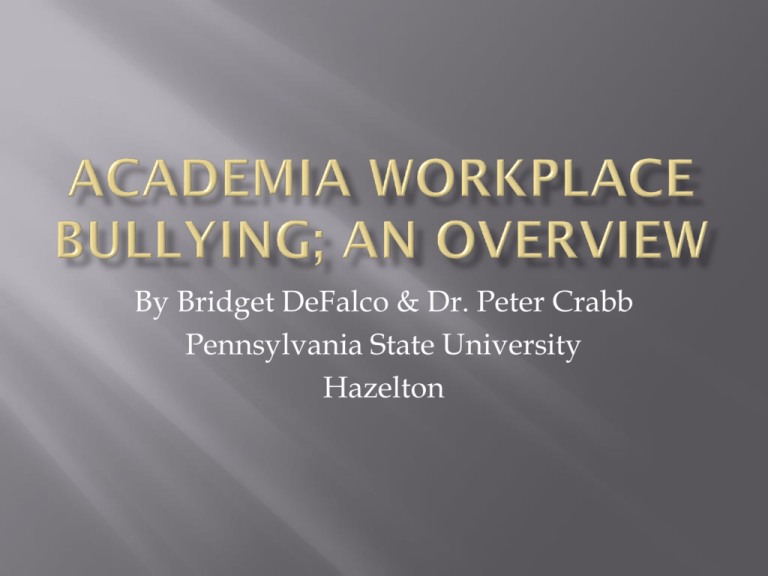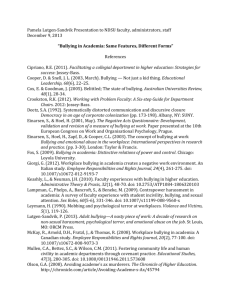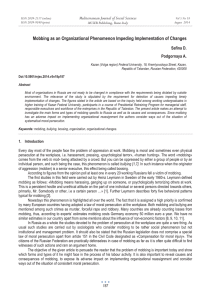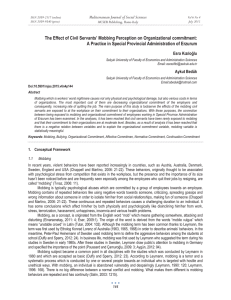Definition of Workplace Bullying
advertisement

By Bridget DeFalco & Dr. Peter Crabb Pennsylvania State University Hazelton Workplace bullying is defined as workplace interaction consisting of any combination of harassment, discrimination, social exclusion, public and professional humiliation, criticism, intimidation, psychological, and sometimes physical abuse that occurs repeatedly and over a period of at least six months Colleagues Usually those whose skills, ethics, and independence are found to be threatening Students Administrators New Hires Untenured Tenured Both Genders Administrators Colleagues Students Contrapower Harassment Both Genders Sense of Inadequacy Females more likely to engage in same-sex bullying People With Power Over Others Incivility Disregarding Your Concerns Ignoring Contributions Intimidation Rumors Subtle Sexism and Racism Undermining Authority Humiliation in Presence of Colleagues Shouting Subordinate Style (Student to Faculty and BottomUp) Belittlement Eye Rolling Unwarranted/Unprofessional Remarks Ostracizing Withholding Information Assigned Unreasonable Workload Excessive Monitoring Exclusion from Relative Meetings Definition: Form of Organizational Pathology in which coworkers gang up and engage in ongoing rituals of humiliation, exclusion, unjustified accusations, emotional abuse, and general harassment in their malicious attempt to force a targeted worker out of their workplace. The Term Originates from the similarities to Bird’s Mobbing Activities Attack on Target Self-Expression Attack on Target Social Relations Attack on Target Reputation Attack on Target Professional Life Attack on Physical & Mental Health of Target PHASE I: Critical Incident Target accused of unacceptable behavior Accusation gives mobbers justification to take administrative actions whether accusation is real or perceived PHASE II: Mobbing & Stigmatizing Aggressive acts and psychological assaults against target More people have co-opted into mobbing process Target has been instilled with terror and fear PHASE III: Personnel Management Administration seriously enters into the mobbing usually after having ignored or minimalized the problem Target is blamed for problem Institution creates explanations based on personal characteristics rather than environmental factors PHASE IV: Incorrect Diagnosis Administration allies with mobbers Target is constructed as “Difficult, Under Extreme Stress, or Mentally Ill” If Target seeks psychological help, Target risks being labeled with incorrect diagnosis such as “Paranoia, Adjustment Disorder, or Character Disorder” PHASE V: Expulsion Target forced out of organization by dismissal or resignation Mobbing process continues to justify actions taken The Targets of Mobbing Generally Honest, Successful, and Loyal to Organization Professors with Many Publications High Salaries High Evaluation Scores Foreign Born Speak with Accent Mobbing Targets Frequently Wish to Leave Jobs, But Many Stay due to Pursuit of Tenure or Because They are Tenured Through Email One-on-one Confrontation Reported as Most Severe Form of Bullying No Witnesses In Meetings In Classrooms Organizational Culture Being “Foreign-Born” Difference from Majority in Sex, Sexual Orientation, or Credentials Belonging to a Discipline with Ambiguous Standards Working Under a Punitive Administrator Member of Financially Strained Academic Unit Power Games Paranoia Manipulative Approach to Management Misdirected Politics Opportunism Mirrored Behavior (Target becomes Bully) Management Ignores or Misinterprets Problem Tenure (or hope of achieving tenure) Extends Length of Time Employees Tolerate Bullying Sleeping in Class (78.3%) Request for Easier Assignments/Exams (76.1%) Engaged in Non-Class Activity During Class (71.3%) Continuous Interruptions During Class (67.5%) Showed Disdain (65.7%) Answered or Talked on Cell Phone (61.3%) Verbally Disrespected or Challenged Authority (60.7%) Interfere with Job Performance Create Hostile Work Environment Increased Employee Turnover Negative Perception of University Reduced Employee Engagement Impact on Health and Welfare of Employee Stress Frustration Anger Demoralization Powerlessness Lowered Self Esteem Increase of Time Wasted Need to talk with colleague repeatedly Behaviors Learned and Values Learned at University Carried by Students into Workplace Legal Issues Governmental Legislation Required Damage to Target is an Injury Workplace Safety and Health Issue In Extreme Cases, Can Lead to Suicide Lack of Commitment to Staff Higher Absenteeism Bystanders More Likely to Join Mobbers than Show Compassion toward Target Implement Policies on Workplace Behavior Specify What Constitutes Bullying (Harassment) Process for Dealing With Bullying Cases Consequences for Frivolous Claims Educational Program for Faculty, Administrators, and Staff Prohibit Harassing Communication Between Faculty Effective Counseling Intervention at All Levels Early Management Intervention Focus on Situation, Not the People Employee Commitment to Stop Bullying Academic Bullying is a Type of Psychological Bullying that Predominantly Occurs at Colleges and Universities. Academic Bullying Will Not Stop until Colleagues and Administrators Actively Say “NO” to Bullying Behaviors Cassell, M.A. Bullying in Academe: prevalent, significant, and incessant. Contemporary Issues in Education Research, 4. 33-44. Fogg, P. (2008). Academic bullies. The Chronicle of Higher Education, 55. B10-B13. Giorgi, G. (2012). Workplace bullying in academia creates a negative work environment. An Italian study. Employee Responsibility and Rights, 24. 261-275. Gravios, J. (2006). Mob rule. The Chronicle of Higher Education, 52. A10-A12. Keashly, L. & Neuman, J.H. (2010). Faculty experiences with bullying in higher education. Administrative Theory & Praxis, 32. 48-70. doi: 10.2753/ATP1084-1806321103 Keim, J., & McDermott, J.C. (2010). Mobbing: workplace violence in the academy. The Educational Forum, 74. 167-173. doi: 10.1080/00131721003608505 Khoo, S.B. (2010). Academic mobbing: hidden health hazard at workplace. Malaysian Family Physician, 5. 61-67. Lampman, C., Phelps, A., Bancroft, S. & Beneke, M. (2009). Contrapower harrassment in Academia: a survey of faculty experience with student incivility, bullying, and sexual attention. Sex Roles, 60. 331-346. doi: 10.1007/s11199-008-` 9560-x Leymann, H. (1990). Mobbing and psychological terror at workplaces. Violence and Victims, 5. 119-129. McKay, R., Arnold, D.H., Fratzl, J., & Thomas, R. (2008). Workplace bullying in academia, a Canadian study. Employee Responsibility and Rights Journal, 20, 77-100. doi: 10.1007/s10672-008-9073-3 Raineri, E.M, Frear, D.F., & Edmonds, J.J. (2011). An examination of the academic reach of faculty and administrator bullying. International Journal of Business and Social Science, 2. 22-35. Tigrel, E.Y., & Kokalan, O. (2009). Academic Mobbing in Turkey. Work Academy of Science, Engineering and Technology, 55, 963- 970. Zabrodske, K. & Kveton, P. (2013). Prevalence and forms of bullying among university employees. Employee Responsibility and Rights Journal, 25. 89-108. doi: 10.1007/s10672-012-9210-x



![04 Psychological wellbeing [MS Word Document, 123.0 KB]](http://s3.studylib.net/store/data/007278191_1-f429aaf4a36d7c754bb90ae765976ef6-300x300.png)



